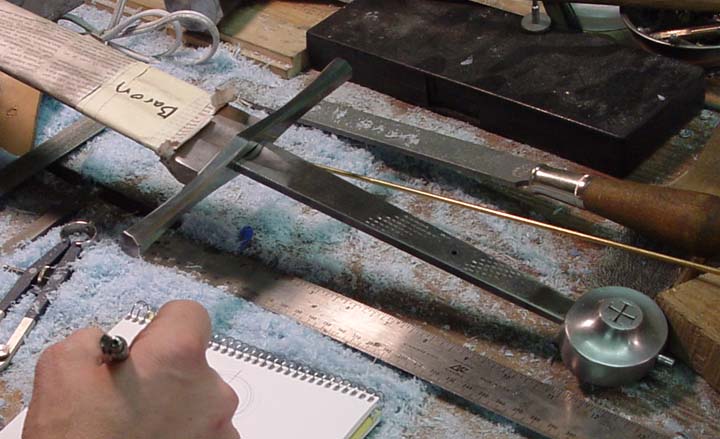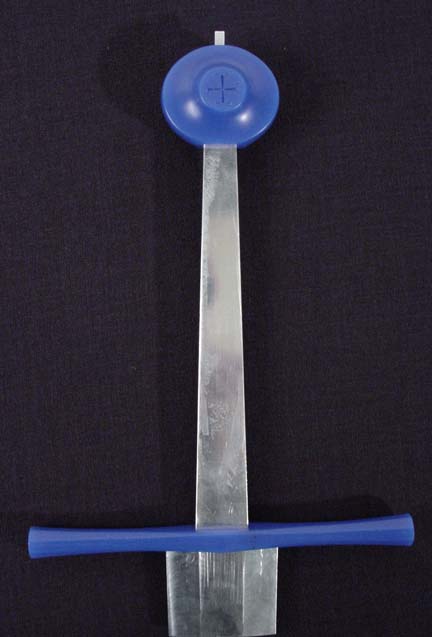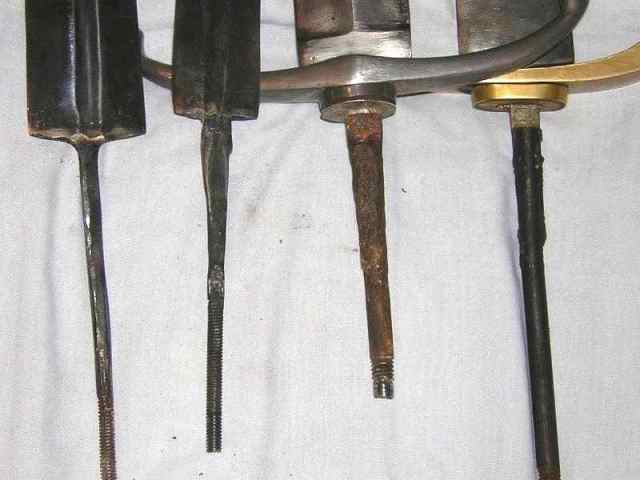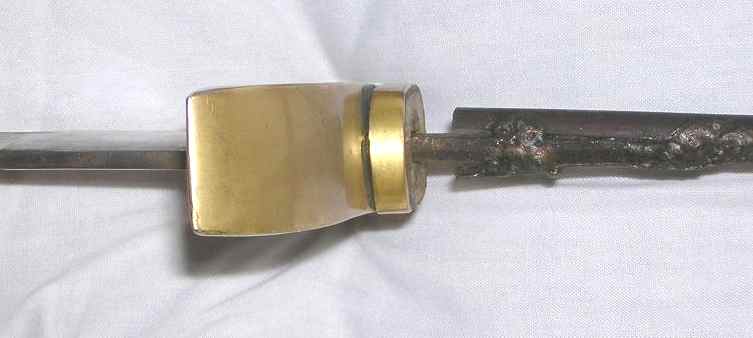I ask the question because of several recent threads about how one should always look
at the tang before buying a sword, accounts of swords breakage at the tang, etc. Why are they made
that way? I am not an expert in Japanese swords either, but they seem to _never_ break
at the tang, and you can see why -- the tang is so beefy. I can't imagine that cost is the
reason for narrow tangs, so why?
I searched for a while and didn't find this discussed, but I do apologize if this is something
that is regularly discussed that I have missed.
-Richard
Well, from my experience...
Japanese swords often had a tang that did not run the entire length of the handle, but instead 3/4 of the way. It also did not 'fill' the handle like today's more modern "full tang" knives or swords (which have a thick tang with two wood or plastic scales pinned to either side). The wide tang on a Japanese sword is also a result of the overall blade thickness - katana blades are fairly narrow compared to, oh, a western broadsword.
Western tangs need to be more narrow than the blade so that you can fit your hand around them (and they handle they are contained within). However, the tang should not be extremely skinny, as they are in many cheap/wallhanger swords out there. That is simply an example of a company trying to cut production costs.
Here is a good example of a nice tang:
[ Linked Image ]
That's the Albion Next Generation Gaddhjalt, a "viking" sword.
Japanese swords often had a tang that did not run the entire length of the handle, but instead 3/4 of the way. It also did not 'fill' the handle like today's more modern "full tang" knives or swords (which have a thick tang with two wood or plastic scales pinned to either side). The wide tang on a Japanese sword is also a result of the overall blade thickness - katana blades are fairly narrow compared to, oh, a western broadsword.
Western tangs need to be more narrow than the blade so that you can fit your hand around them (and they handle they are contained within). However, the tang should not be extremely skinny, as they are in many cheap/wallhanger swords out there. That is simply an example of a company trying to cut production costs.
Here is a good example of a nice tang:
[ Linked Image ]
That's the Albion Next Generation Gaddhjalt, a "viking" sword.
Last edited by Timothy Gulics on Tue 13 Apr, 2004 11:53 am; edited 1 time in total
Others will undoubtedly go into much deeper thoughts than I, but the basic reason why modern replicas of western swords have narrow tangs is because the makers are cheep.
Albion, A&A, Lutel and many other custom and higher end manufacturers make their blades with nice beefy tangs.
As well, historically western swords have nice beefy tangs as well.
Albion, A&A, Lutel and many other custom and higher end manufacturers make their blades with nice beefy tangs.
As well, historically western swords have nice beefy tangs as well.
Isn't this tang beefy enough?
[ Linked Image ]
Western tangs were of varying width (and thickness), depending on blade style.
[ Linked Image ]
Western tangs were of varying width (and thickness), depending on blade style.
Hi Richard,
The tiny tang is a modern production issue rather than an inherent design problem. For whatever reason (cost most probably, or a genuine lack of knowledge) some modern manufacturers (Valiant armoury for example) make very insecure tangs, either too narrow, or welded in the middle. From what I have seen and heard, period weapons had a tang width of ~1/2 to 1/3 the width of the blade. That is also how respectable companies make their swords. I have included a picture of an Albion sword tang. If you were to visit their website or go to the Albion Next Gen thread you will see may more such pictures representing different models. The same holds true for A&A (USA) and ATrim swords. It does seem that the tang of medieval european swords is not as wide as that of katanas, but history has shown that it does not need to be so large to give you a solid piece.
The reason why checking the tang before purchasing a sword is important is because most of the swords (if you can call them that) that are being sold on the web do not come from the respectable makers, and the tangs are very often pensil thin. I have been a victim of "rat-tail" tang design, but considering the maker and the price I paid that was to be expected.
Cheers,
Alexi
 Attachment: 77.38 KB
Attachment: 77.38 KB

 Attachment: 38.43 KB
Attachment: 38.43 KB

The tiny tang is a modern production issue rather than an inherent design problem. For whatever reason (cost most probably, or a genuine lack of knowledge) some modern manufacturers (Valiant armoury for example) make very insecure tangs, either too narrow, or welded in the middle. From what I have seen and heard, period weapons had a tang width of ~1/2 to 1/3 the width of the blade. That is also how respectable companies make their swords. I have included a picture of an Albion sword tang. If you were to visit their website or go to the Albion Next Gen thread you will see may more such pictures representing different models. The same holds true for A&A (USA) and ATrim swords. It does seem that the tang of medieval european swords is not as wide as that of katanas, but history has shown that it does not need to be so large to give you a solid piece.
The reason why checking the tang before purchasing a sword is important is because most of the swords (if you can call them that) that are being sold on the web do not come from the respectable makers, and the tangs are very often pensil thin. I have been a victim of "rat-tail" tang design, but considering the maker and the price I paid that was to be expected.
Cheers,
Alexi


Photos I've seen of original European sword tangs vary widely. Most viking era pieces I've seen had consistently wide parallel tangs that were often thicker in cross section than the blade. I've seen tangs on war swords and high medieval swords that were similar but I have also seen tangs on some of these swords as well as some two-handed claymores that were nearly rat tails. These latter, though, usually started at the shoulder with widths approaching a third of that of the blade. This re-enforces the need of a tight fitting hilt to distribute stress evenly throughout grip and tang. If I remember correctly the tang on the Edward III sword (X-rayed in Records of the Medieval Sword) and Oakeshott's swiss hand and a half ( shown in the same work disassembled) fall in between these two extremes.
[ Linked Image ]
[ Linked Image ]
[ Linked Image ]
[ Linked Image ]
[ Linked Image ]
[ Linked Image ]
[ Linked Image ]
[ Linked Image ]
[ Linked Image ]
[ Linked Image ]
[ Linked Image ]
[ Linked Image ]
[ Linked Image ]
Most of the modern problems result from cheap threaded screw parts being welded to the blade, often near the shoulder where much of the stree builds up in use.
Donnie S. had posted this pic of a few of his antique baskethilt tangs ( the two middle ones look like they've been repaired, or re-welded, ? ) .
[ Linked Image ]
Mac
[ Linked Image ]
Mac
After looking at Mac's pictures, I guess my question would be are "beefy" tangs really necessary? Many, many weapons have really small, flimsy spike-like tangs attached with resin (e.g. tulwar and dha), and Chinese tangs have never impressed me with their robustness.
Dha (courtesy of Mark Bowditch):
http://members.cox.net/bowditchm/dha1a.jpg
Jian:
http://img3.photobucket.com/albums/v12/cha-con/021.jpg
Dao:
http://img3.photobucket.com/albums/v12/cha-con/1_990_11.jpg
Dha (courtesy of Mark Bowditch):
http://members.cox.net/bowditchm/dha1a.jpg
Jian:
http://img3.photobucket.com/albums/v12/cha-con/021.jpg
Dao:
http://img3.photobucket.com/albums/v12/cha-con/1_990_11.jpg
| Andrew Winston wrote: |
| After looking at Mac's pictures, I guess my question would be are "beefy" tangs really necessary? Many, many weapons have really small, flimsy spike-like tangs attached with resin (e.g. tulwar and dha), and Chinese tangs have never impressed me with their robustness. |
I think it is safe to say that all of the pictured tangs so far are pretty robust at the shoulder but become narrower towards the pommel. Also all of the so far pictured tangs are "functional". For contrast I have included two pictures courtesy of Nathan Cole which were shown on another thread. These are the kinds of tangs that are the cause of failure we so often hear about. Especially note the first and last swords on the picture.
Cheers,
Alexi


[ Many, many weapons have really small, flimsy spike-like tangs attached with resin (e.g. tulwar and dha), and Chinese tangs have never impressed me with their robustness.
I have never heard of a tang attached to the blade with resin. The examples you site are typically integral blade/tangs attached to the hilt with resin.
I have never heard of a tang attached to the blade with resin. The examples you site are typically integral blade/tangs attached to the hilt with resin.
Ewww... those ugly tangs are terrible. I've seen wallhangers with better, cleaner tangs.
Conversely, if you look at the tang on the Albion Baron, it is THICK and juicy. Like a good steak. Mmm... swordsteak...
I might have to reconsider saving up for a Next Gen. But which one?!
Conversely, if you look at the tang on the Albion Baron, it is THICK and juicy. Like a good steak. Mmm... swordsteak...
I might have to reconsider saving up for a Next Gen. But which one?!
| Timothy Gulics wrote: |
|
I might have to reconsider saving up for a Next Gen. But which one?! |
The Castellan
The Baron
The Duke
The Count
The Chieftain
The Landgraf
The Sempach
The Regent
The Viceroy
Hope that helps :lol:
| Quote: |
|
Especially note the first and last swords on the picture. |
Actually, the 2nd from left scares me most - there are TWO welded joints with tiny little tabs - no lateral support at all.
OK, the last picture scares me MOST, but that's just rediculous, that must be a poor repair job.
Walt
I have had the pleasure or displeasure i should say to have repaired a handful of not so cheap "battle ready" swords for some local collectors. I wont say which swords they were but they were imports from the Phillipines and India. After dissassembling these swords i found the tangs to be very wimpy even on the claymores. Also (i was amazed by this) the blade, hilt and pommel had control numbers on them. These are supposed to be used to identify which parts fit which blade tightly which they didnt. The handle, hilt and pommel were loaded with epoxy to take up any of the slop when it cures. So why did they use control #s? I m completely baffled. So after removing all of the epoxy i made tiny steel shims to fit into all the gaps which when the pommel compressed everything again seemed to work quite well. I personally will never buy one of these import swords for safety concerns. They look pretty nice but they are very shabby in their construction.
Just my 2 cents
John
Just my 2 cents
John
| Walt Ligon wrote: |
|
OK, the last picture scares me MOST, but that's just rediculous, that must be a poor repair job. Walt |
The split threaded rod welded to the short tang is the way the sword came(brass hilt). The sword next to it with the steel hilt has the same tang construction. I assume this is how most of their swords are made at least for this line. The annoying thing is the cross can't be removed because the tang is wider than the opening in the cross. That would be ok if the cross were solid but it rattles and I have resorted to superglue to solidify the hilt. Although it looks rather bad the sword (with hilt on) seems fairly solid. I have chopped at 1-2" branches (not through since there is not much of an edge) and hacked up flying pumpkins with this sword. I hesitate to try anything more but so far they seem reasonably ok for the price.
Nathan
| Allen W wrote: |
| [ Many, many weapons have really small, flimsy spike-like tangs attached with resin (e.g. tulwar and dha), and Chinese tangs have never impressed me with their robustness.
I have never heard of a tang attached to the blade with resin. The examples you site are typically integral blade/tangs attached to the hilt with resin. |
Of course. I was being imprecise. It just never occured to me that anyone would think I was suggesting that the tang would actually be attached to the blade with resin, particularly after viewing a photo of the dha tang I attached to my post.
My point was that this type of tang is typically short, thin and tapered, not unlike a "cutnail". Not long and thick, nor "through handle". No peened or threaded pommels, or pins either. If thick, beefy, full-length tangs are critical, why are there so many examples of short, thin tangs?
I imagine method of use may have an impact on tang structure, with chops and hacks placing more lateral stress on the handle/blade junction than slices or draw cuts. However, many spike-tanged weapons invite hacks and chops.
Resin attachment is certainly much more prone to failure due to age and deterioration, and tulwar with riveted blades are not uncommon, although it is debateable as to whether those are evidence of later reinforcement due to deteriorating fixation.
Andrew none of the swords you illustrate are very narrow near the shoulder where I would expect most stress to occur as blade flexion ceases at this point. However these tangs lack the edge bevel of the blade and thus represent more steel in relation to width when measured against the blade. I think the main relevance of tang length is how its terminus effects pivot and leverage of the blade against the hilt with longer generally being better.
| Allen W wrote: |
| Andrew none of the swords you illustrate are very narrow near the shoulder where I would expect most stress to occur as blade flexion ceases at this point. However these tangs lack the edge bevel of the blade and thus represent more steel in relation to width when measured against the blade. I think the main relevance of tang length is how its terminus effects pivot and leverage of the blade against the hilt with longer generally being better. |
Agreed, Allen. I've yet to see a spike-tanged weapon suffer a failure of the tang itself. Failure invariably occurs between the handle and tang, either by failure of the adhesive, or the handle itself.
Page 1 of 2
You cannot post new topics in this forumYou cannot reply to topics in this forum
You cannot edit your posts in this forum
You cannot delete your posts in this forum
You cannot vote in polls in this forum
You cannot attach files in this forum
You can download files in this forum
All contents © Copyright 2003-2006 myArmoury.com — All rights reserved
Discussion forums powered by phpBB © The phpBB Group
Switch to the Full-featured Version of the forum
Discussion forums powered by phpBB © The phpBB Group
Switch to the Full-featured Version of the forum